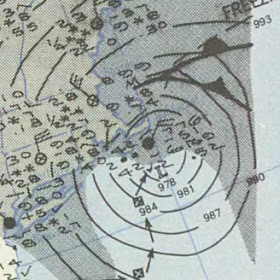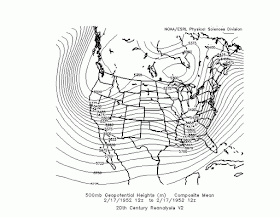A weather-related movie opened today, one I saw earlier this week at a studio preview: the Finest Hours, the story of an extraordinary rescue of the crew of a tanker that split in two off the coast of Cape Cod on February 17-18, 1952 during a very powerful nor'easter.
In this movie, Coast Guardsman Bernard Webber and three volunteers headed offshore near Chatham, Massachusetts in a 36-foot wooden motorized lifeboat in 60-foot seas and 70-knot winds, rescuing 32 crewmen from the stricken tank vessel Pendleton.
This was a very strong storm, noted for heavy snowfall offshore and destruction of not one, but TWO, World War II era ships in the offshore waters. As a meteorologist, I was curious about this powerful cyclone and tried to find some weather information. Let me show you what I found.
Turning to the NOAA/NWS historical surface map website, I first found the surface chart for 7 AM Sunday, Feb. 17th (see below). This map shows the fronts, sea level pressure, and areas of precipitation (shaded). You will note a weak low along the Delaware coast, with a central pressure of around 1004 hPa.
At the Boston Airport (some distance from the strongest winds), sustained winds hit 50 mph and the gusts would have hit 60-70 mph. Worse over the water. Pressure dropped to 989 hPa at Boston, with temperatures in the lower 30s,
Snow was intense NE of the low center; as shown below, Portland Maine had it 4th worst snow event in the entire observational record:
1) 31.9" Feb. 8-9, 2013
2) 27.1" Jan. 17-18, 1979
3) 25.3" Feb. 17-18, 1952
4) 23.8" Jan 26-28, 2015
The upper level flow pattern (500 hPa, around 18,000 ft) showed a sharp trough over the eastern US on Sunday AM:
The upper trough rapidly deepened into an amazingly intense upper level low over the next 24 h.
There was no weather satellites or operational weather radars during that period....sorry.
The Feb 1952 was a powerful storm and certainly in the top 50 for nor'easter events. But it was't in the first tier and certainly far weaker than Sandy or other mega-events.
Movie Comments: A B picture which starts VERY slowly with a boring relationship angle. Not much talk about meteorology. A shame really.
Movie Comments: A B picture which starts VERY slowly with a boring relationship angle. Not much talk about meteorology. A shame really.








Regarder THE FINEST HOURS Full Film : http://thefinesthours.org
ReplyDeleteHi Cliff,
ReplyDeleteIt would be interesting to see a similar analysis of the conditions when the Edmund Fitzgerald sunk on Lake Superior
https://en.wikipedia.org/wiki/SS_Edmund_Fitzgerald
There is a great song about that too-
https://www.youtube.com/watch?v=hgI8bta-7aw
Thanks, Isaac
4th worst but, looking at the dates, worst up to that point.
ReplyDeleteCliff, I believe the Standard Hollywood Screenwriter software template includes the Troubled Relationship Story module by default. It can be swapped out for the Misunderstood Teen Loner module or the Tragic Father Figure Three Days From Retirement module or the Plucky and Talented Teenage Girl With a Dream module, but not removed entirely.
ReplyDeleteI kid, I kid... I think.
I am impressed that they gathered that much sophisticated weather data at that time, actually. The wreck of the Edmund Fitzgerald is made more impressive (and tragic) to me by the fact that it happened much more recently than you'd guess... it was fresh news when Gordon Lightfoot wrote that song. I really don't understand why the captain decided to go out into that storm so heavily laden; they must have known it was coming? Maybe the weather there is always so potentially threatening in the winter that you just have to go or you'll never go.
ReplyDelete